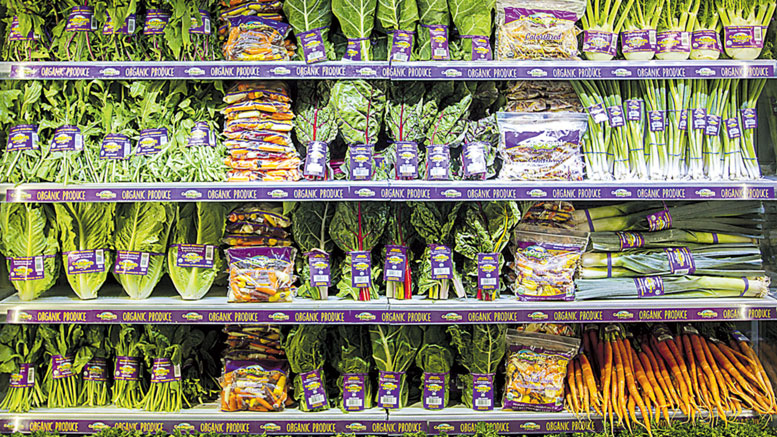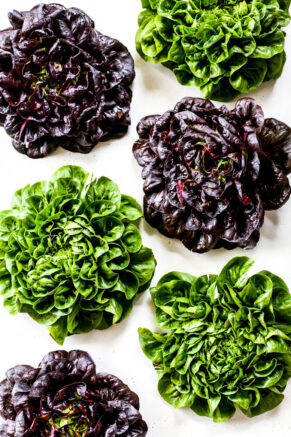Foodservice Influence Brings Changes for Retail Leafy Greens
January 3, 2024 | 6 min to read
New lettuce varieties from major growers like Church Brothers Farms and Babé Farms are enhancing retail options, driven by foodservice demand. Innovations such as Little Gem, Petite Romaine, and Baby Butter Cakes cater to consumer preferences for flavor and texture. These products not only perform well in taste tests but are also versatile, enhancing meal preparations. Retail sales have surged post-pandemic, reflecting robust interest in diverse, high-quality leafy greens.

PHOTO COURTESY GRIMMWAY FARMS
New lettuce varieties give retailers fresh new products.
Originally printed in the December 2023 issue of Produce Business.Major leafy greens grower-packer-shippers are indicating that foodservice demand for their products has influenced sales for the retail trade.
Recently developed new lettuce varieties and corresponding options are giving retailers fresh new products.
Church Brothers Farms’ sales of these developing products were largely introduced in the foodservice realm, according to Ernst van Eeghen, vice president of foodservice business development in Salinas, CA. The new varieties are enjoyed at home by consumers to the benefit of produce retailers.
“Produce trends very often come out of foodservice because the volumes are so much larger in foodservice sales,” notes van Eeghen. “A lot of these trends have just risen with anchor customers that could take thousands of cases a week, and then once you have a good supply base or a good growing base, it’s much easier to tack on the retail business.”
Similarly, Matt Hiltner, marketing coordinator, Babé Farms, Inc., Santa Maria, CA, tells Produce Business, “Our primary leafy greens consumers come from the foodservice sector and as inflation causes prices to soar across the supply chain, chefs are looking for ways to cut costs in the kitchen. One-cut lettuces that require minimal prep time are rising in popularity and we are increasing the size of our plantings in reaction to this. Some great examples are our Ro-Minis brand and Ruby Ro-Minis brand, and our new Baby Butter Cakes brand.”
Van Eeghen, who has worked for Church Brothers since 2007, works with Alex McCloskey, vice president of retail business development, to nurture new products.
New types of leafy greens coming into the market are moving foodservice and retail sales from the spring mix category to those with more loft and more volume per pound.
“Over the last few years, we’ve seen the non-traditional leafy greens — like the Little Gem — doing really well. People are looking for something other than iceberg lettuce and spring mix to that sweeter flavor and greater crunch you’re getting with these items. The presentation is really strong and brings multiple applications beyond just a salad,” says van Eeghen.
“These whole heads of Little Gems and Petite Romaines can be used for dippers or as a carb-replacement taco alternative. They’re really good for grilling and, of course, for salads, they’re fantastic as well,” he adds.
Shoppers are looking for something other than iceberg lettuce and spring mix to find a sweeter flavor or greater crunch.
Church Brothers’ Little Gem is a cross between butter and romaine lettuces, offering a distinctive sweet flavor with a unique buttery texture in a compact head, while Petite Romaine is a new lettuce variety that Church describes as bringing the best of iceberg and the best of romaine. A two-count Petite Romaine is packed in a bag.
Hiltner describes Babé’s Ro-Minis as cute and compact, while packing “the crunch of iceberg and sweet flavor of romaine into one small, tightly enveloped head.” These can be fileted and grilled. Or the leaves can become “cups or wraps for your choice of dressing and toppings. Its leaves hold up well to heat and all kinds of dressing. What sets Ruby Ro-Minis apart is their decadent leaves which possess an ornate speckled pattern.”

Baby Butter Cakes brand is the latest addition to Babé’s collection of luxury leafy greens. These petite heads of butter lettuce, available in both green and red varieties, derive their name from their delectable buttery flavor and captivating cake-like shape. These luxury lettuces boast three times the number of leaves compared to an average butterhead lettuce, and each piece maintains a uniform shape and size, according to Hiltner.
Over the last three or four years, van Eeghen says, Church Brothers has “focused really heavily on variety selection. We have been trying dozens of varieties throughout the seasons and the different growing regions.”
These have brought lettuces with “really strong performance as far as yield but also flavor and crunch. Those are the ones that we are really looking at.”
Church Brothers’ vegetable breeding program develops varieties that are suited to the firm’s growing areas, which are the Salinas Valley, Yuma and the Imperial Valley, as well as central and northern Mexico. The company’s Tuscan Salads blend has five different red and green lettuces that are “very lofty, springy, sweet, crunchy and they have 25% more volume than traditional spring mix. So, that is a category that’s being explosively growing,” notes van Eeghen.
Church Brothers also offers a full line of cut veg, from broccoli, cauliflower, florets, slaws, Brussels sprouts and cauliflower rice. To complement the variety, they are offering beans, snap and snow peas.
To complete its retail assortment, the company added three new clamshell items: full-leaf Romaine, whole-leaf green leaf, and a four-count Little Gem clamshell, along with a two-count petite romaine packed in a gusseted bag. “These items are seeing strong growth because they merchandise really well at store level.”
Church’s retail program “really took off after the pandemic with the creation of this full assortment,” says van Eeghen. The company also beefed up its retail staff under the direction of McCloskey.
Babé Farms harvests lettuce and leafy greens on a year-round basis in the Santa Maria Valley growing region. “While we were impacted by the rains earlier this year, the mild weather that followed has allowed us to get our planting and harvest schedules back on track in time for the summer and fall seasons,” says Hiltner.
Despite the challenges posed by inflation, Babé Farms has managed to maintain relatively stable pricing compared to last year. “While the future remains uncertain, we are planting with confidence and hold an optimistic outlook for our business in 2024. We are committed to delivering high-quality leafy greens to our customers while navigating economic fluctuations.”
Although he’s lived in the United States for 25 years, van Eeghen is a native of Holland. “In our business, many of the seed breeders are in Holland and they’re very dominant in this space, so it’s definitely an advantage that I can speak their language and understand the way they do business.”
• • •
Organic Greens Holding Steady
Data from Numerator, a market research industry data and tech company with consumer-sourced data, shows household penetration for organic and conventional fresh lettuce was higher in the last 52 weeks compared to 2019, prior to the pandemic, says David Bright, vice president of marketing at Grimmway Farms, Bakersfield, CA. Cal-Organic Farms is a division of Grimmway.
Purchase frequency increased a bit for conventionally grown lettuce and dropped a bit for organically grown lettuce, suggesting some shoppers switched for budgetary reasons or limited organic purchases to avoid spoilage.
According to Circana, a firm that provides information and insights on consumer behavior, while retail lettuce sales volume overall is steady compared to last year and down less than 2% compared to 2019, retail organic lettuce sales growth has been sustained, up 7% in the last 52 weeks compared to 2019.
Organic lettuce sales volume growth has been particularly high, up 38%, in the Southeast. Organic dandelion sales volume in the West tripled since 2019, and in California, 75% higher than 2019. The latest 52-week U.S. sales volume of organic dandelion remained 31% higher than 2019; conventional sales volume was 18% higher than 2019.
Organic mustard greens represent another item that took off following the pandemic in California, the Northeast and Great Lakes regions, and sustained volumes are more than 70% higher than in 2019, more than 125% in the Northeast.
Cal-Organic Farms, Lamont, CA, grows and distributes more than 65 varieties of organic vegetables, including a full array of leafy green products such as iceberg, romaine, leaf and butter lettuces, as well as kales, chards and collard greens. Bright says Cal-Organic Farms grows year-round in California, with a seasonal organic vegetable program in Florida and Georgia that begins in November and extends through April.
“Many of our retail customers have had success with our flow-wrapped organic vegetables that extend shelf life and clearly identify organic vegetable products at the checkout stand,” says Bright.
31 of 32 article in Produce Business January 2024

